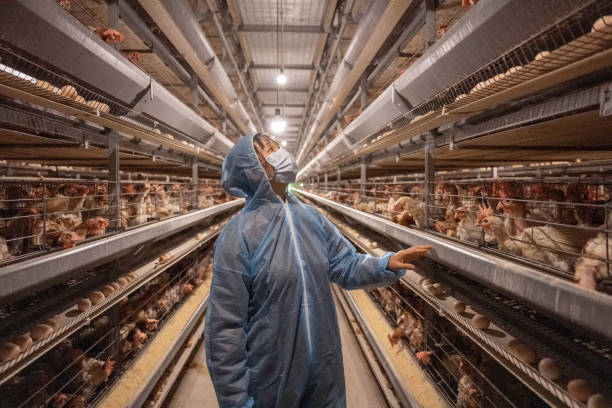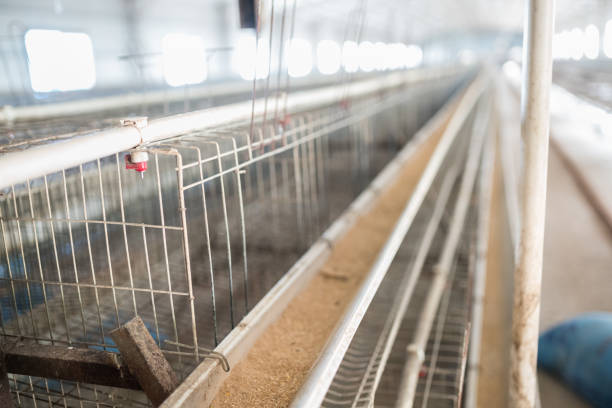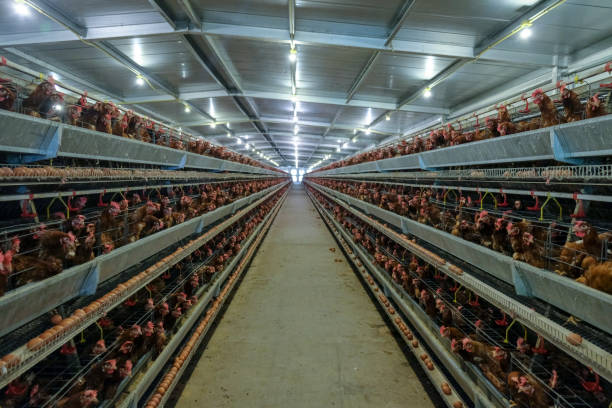Layer Chicken Cage System for 10,000 Chickens Nigeria
Layer Chicken Cage System for 10,000 Chickens Nigeria
If you’re a poultry farmer in Nigeria planning to scale up your egg production with a commercial setup of 10,000 laying hens, choosing the right layer chicken cage system is one of the most important decisions you’ll make. A well-designed cage system not only maximizes space efficiency and bird health but also significantly boosts your farm’s productivity and profitability. At Livi Mechanical, with over a decade of experience crafting smart poultry solutions for African markets — especially Nigeria — we know exactly what it takes to run a high-performing layer operation under local conditions.
Nigeria’s growing population and rising demand for eggs have made large-scale poultry farming more attractive than ever. However, managing 10,000 birds manually without proper automation can quickly turn into a logistical nightmare. That’s where a modern layer chicken cage system comes in. Designed for durability, hygiene, and ease of maintenance, our systems are built to handle Nigeria’s climate while delivering consistent performance year after year. From automatic feeding and drinking lines to manure removal belts and stackable three-tier cages, every component is tailored to help farmers reduce labor costs, minimize feed wastage, prevent disease outbreaks, and increase egg yield per hen.
We’ve worked with dozens of Nigerian clients who started with confusion about cage types, house design, ventilation needs, or even power supply requirements — all valid concerns when investing in such a big project. But through careful planning and customized design, they now operate smoothly, producing thousands of fresh eggs daily with minimal stress. In this article, we’ll walk you through everything you need to know before installing a 10,000-bird layer cage system in Nigeria — so you can make smart, informed decisions and avoid costly mistakes.
### Choosing the Right Cage System for 10,000 Layers
When setting up a commercial layer farm, not all cage systems are created equal. For a 10,000-chicken operation, the ideal choice is typically a **fully automated A-frame three-tier cage system** — which is exactly what we recommend and supply across Nigeria. Let’s break down why this configuration works best:
The A-frame design allows two rows of cages back-to-back, maximizing the number of birds housed per square meter while leaving adequate space for walkways and equipment access. With three tiers (levels), each holding one bird per compartment, you can accommodate around 90–96 hens per cage unit. This means you’d need roughly 104–110 cage units to house 10,000 layers — depending on exact size and layout.
Each tier includes galvanized wire mesh flooring that ensures good air circulation and allows droppings to fall through, keeping birds clean and reducing ammonia buildup. The cages are coated with anti-rust materials suitable for Nigeria’s humid southern regions as well as dry northern climates. We use heavy-duty steel frames that support long-term durability — even under constant use and frequent cleaning.
Automation plays a huge role here. Our standard package includes:
– Automatic feeder lines (chain or aerial type) ensuring uniform feed distribution
– Nipple drinking systems with pressure regulators to prevent leaks
– Manure belt conveyors that collect waste regularly, improving hygiene
– Egg collection belts that gently roll eggs to a central collection table
These features drastically cut down on labor. One worker can manage feeding and egg gathering for the entire flock in less than an hour — imagine trying to do that by hand!
Another critical factor is ventilation. In Nigeria, temperatures can soar above 35°C, especially during the dry season. Overheating leads to reduced egg production, poor shell quality, and increased mortality. That’s why we integrate tunnel ventilation systems with cooling pads and exhaust fans into the house design. Proper airflow keeps hens comfortable and productive all year round.
And don’t forget lighting control. Hens need consistent light cycles (usually 14–16 hours per day) to maintain peak laying performance. Our farms come equipped with programmable LED lighting systems that simulate natural daylight patterns — helping regulate the birds’ biological clocks and boost egg output.
### Planning Your Poultry House Layout and Infrastructure
Setting up a 10,000-layer farm isn’t just about buying cages — it’s about creating a complete ecosystem that supports maximum efficiency. The first step is calculating your required building dimensions. A typical A-frame three-tier system needs a poultry house measuring approximately **70 meters long × 12 meters wide × 4 meters high** (about 230 ft × 39 ft × 13 ft). This gives you enough room for double rows of cages, side aisles, a central passage, feed storage, and mechanical systems.
Before construction begins, consider these key elements:
– **Foundation and floor**: Concrete slab with proper slope for drainage
– **Walls and roofing**: Insulated sandwich panels or zinc sheets with thermal lining to reduce heat absorption
– **Entry points**: Double doors at both ends for easy movement of equipment and personnel; separate service gate for egg collection
– **Electrical setup**: Dedicated circuit for fans, lights, conveyors, and water pumps — backup generator highly recommended due to unstable grid power
Water availability is another major concern. Each hen drinks about 250–300ml per day, meaning you’ll need a reliable source capable of supplying **2,500–3,000 liters daily**. Boreholes are common in Nigeria and often the best option. Make sure your water tanks are elevated and connected to a pressure tank system to ensure steady flow to the nipple drinkers.
Feed storage must be secure and rodent-proof. Plan for at least **8–10 tons of layer mash per week**, based on average consumption of 110–120g per bird per day. Use silos or sealed bins located near the feed line inlet. Automated feeding reduces spillage and saves around 10–15% in feed costs over time.
Waste management should never be an afterthought. With 10,000 birds, you’re looking at roughly **1–1.2 tons of manure per day**. While some farmers sell dried manure as organic fertilizer, others compost it on-site. Either way, regular removal via conveyor belts prevents fly infestations and respiratory issues in birds.
Biosecurity is also essential. Set up a footbath at the entrance, require workers to wear dedicated boots and coveralls, and restrict visitor access. Install insect screens on windows and fan openings to keep pests out.
Finally, think ahead: Will you want to expand later? Can the current structure handle additional units? Designing with scalability in mind saves money and time down the road.
### Why Nigerian Farmers Trust Livi Mechanical for Large-Scale Projects

Over the past decade, we’ve installed hundreds of layer cage systems across Nigeria — from Ogun State to Kaduna, Enugu to Kano. What sets us apart isn’t just the quality of our equipment, but the end-to-end support we offer every client.

We start with a free consultation to understand your goals, land size, budget, and existing infrastructure. Then we design a custom plan including house layout, cage specs, ventilation strategy, power requirements, and estimated timelines. If needed, we can connect you with trusted contractors familiar with poultry farm construction in your region.
Once approved, we manufacture your cage system in our Zhengzhou factory using precision welding and hot-dip galvanization — superior to cold-galvanized alternatives found elsewhere. All parts are pre-assembled, numbered, and packed securely for shipping. Most containers reach Lagos or Onne ports within 30–40 days.
Upon arrival, our team can dispatch engineers to supervise installation, train your staff on daily operations and maintenance, and ensure everything runs smoothly from day one. Whether you speak English, Yoruba, Hausa, or Igbo, communication won’t be a barrier — we work with local agents who assist with coordination.
After delivery, we continue supporting you with spare parts supply, troubleshooting advice, and remote monitoring options. Many of our Nigerian customers now use simple WhatsApp videos to show us issues — and we guide them through fixes instantly.
Our clients report impressive results:

– Feed conversion ratio improved by up to 18%
– Egg production rates between 90–94% sustained over 12 months
– Labor cost reduction of 60% compared to deep litter systems
– Mortality rate below 5%, thanks to better hygiene and climate control
One farmer in Ibadan went from losing money on sick birds to exporting eggs weekly — all because he switched to a properly ventilated, automated Livi cage system. Another in Abuja expanded from 5,000 to 20,000 layers within two years, reinvesting profits earned from higher efficiency.
We’re not just selling cages — we’re building partnerships for long-term success.
Got questions about starting or upgrading your layer farm? Want a FREE site plan and quote for your 10,000-bird project?
Message us today with your location, available land size, and preferred capacity. Our experts will respond within 24 hours with a full proposal — no obligations, just clear answers.
—
**Frequently Asked Questions**
What is the cost of a layer chicken cage system for 10,000 birds in Nigeria?
Pricing depends on automation level and shipping terms, but expect between $45,000–$65,000 FOB China. This includes cages, feeders, drinkers, manure belts, egg collection system, and technical support.
How much space do I need for 10,000 layer cages?
You’ll need a poultry house of about 70m x 12m (840 sqm), plus extra space for feed storage, egg room, and office/shed.
Can I install the system myself?
Yes, with basic tools and guidance. We provide detailed manuals and videos. For faster setup, we can send a technician for supervision.
Do you offer payment plans or financing options?
While we don’t offer direct loans, we accept LC payments and can split shipments into phases to ease cash flow.
Is the equipment suitable for Nigeria’s weather?
Absolutely. Our cages are hot-dip galvanized for rust resistance, and ventilation systems are designed specifically for tropical climates.
How many workers do I need to run a 10,000-bird cage farm?
With full automation, 2–3 trained workers can manage daily operations comfortably.
How long does it take to receive the equipment after ordering?
Production takes 15–20 days, plus 30–40 days shipping to Nigeria. Total delivery time is roughly 6–8 weeks.
Can I upgrade from manual to automatic later?
Yes, but it’s more cost-effective to go fully automated from the start. Retrofitting can be complex and expensive.
Do you supply chicks or feed?
We focus on equipment, but we can recommend reliable suppliers of day-old pullets and quality feed formulations used by other Nigerian clients.
How long do the cages last?
With proper care, our galvanized cages last 15+ years. We’ve had farms still using original systems from 2015 with minimal repairs.




